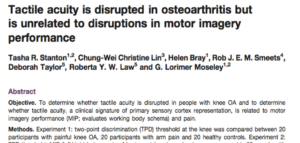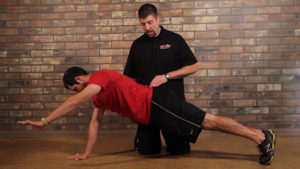by Mitch Hauschildt, MA, ATC, CSCS
Over the past couple of weeks, I have had another very interesting and fun case to work with. The athlete is in his 4th year of playing for us, so we have a long history with him, but my involvement has been somewhat limited as he has worked primarily with one of my coworkers. The short history is that he has had 2 posterior capsule repairs to his shoulder and 9 months after his second repair, he is still struggling with pain, weakness and instability. He has been complaining about consistent shifting of his humeral head with small movements like giving his teammates high fives and tucking his pants in.
Clinically, he doesn’t present as grossly unstable, but his subjective complaints point in the direction of a failed surgical procedure. Repeat MRIs haven’t been much help because they are typically just showing us “post operative changes” within the posterior capsule and it is hard to gauge the true health and quality of that tissue. If you know much about the posterior capsule of the shoulder, you know that repairs performed in that area can be problematic due to the poor nature of that tissue and somewhat poor blood supply. Our surgeon is honestly one of the best in the business in the shoulder and went in both times reluctantly, but after 2 procedures in that area, he won’t go in again, which I appreciate.
The treatment approach in recent months has been mostly what I would call mechanical in nature. The focus has been on doing everything possible to help him create stability in other ways to make up for a poor posterior capsule and trying to restore as much joint centration as possible. The problem is that nothing seemed to help his pain and feeling of instability. We tried mechanically blocking his posterior shoulder to keep his humeral head in place. We tried postural taping and lots and lots of stabilization exercises. Not only did it not make things better, he was actually complaining of worsening symptoms, even though he hasn’t been doing much at all with regards to exercise.
A couple of weeks ago, I was racking my brain, looking for another solution for this young man. The fact that he complains of gross instability that doesn’t match with his clinical evaluation has never sat well with me. As I thought through this, some questions came to mind.
What if his feeling of instability was actually just poor proprioceptive feedback from his shoulder to his brain?
What if his constant shifting in multiple directions is really his brain’s poor interpretation of where the joint is in space and not actually a true lack of stability?
What if his pain is just a confused nervous system that constantly feels threatened?
In the Rocktape FMT Blades course we talk about several studies that demonstrate that patients with chronic pain have decreased tactile acuity (poor ability to discriminate feeling and touch) in that part of their body. I have taught the material multiple times, but because I work with young, health individuals, I rarely have patients in what I would describe as “chronic pain”, so this thought process with him has never crossed my mind.
Until now…
The first step I took was to assess his tactile acuity. What I quickly found with him was that he had a circle about 10 inches in diameter where he had very, very poor tactile acuity. If I used an IASTM tool to draw letters on his upper arm, rhomboids or cervical spine area, he could nail them right away, every time. But, when I entered into the “circle” on his posterior shoulder, he knew I was touching the area, but couldn’t tell me what letter I was drawing. He clearly had what Moseley and Butler describe as a “smudge” on his brain.
At this moment, I completely changed my treatment strategy. Everything became about the nervous system and improving the brain’s understanding of what was really happening at his shoulder. His season had already started, so we went “all in” on this approach to see how quickly we can make changes.
The treatment approach included the following:
- Graphesthesia Training: This is a fairly new co
ncept to me, but it is a fairly simple one. Draw letters, numbers, shapes or something recognizable on the skin and have the patient tell you what you are doing. Over the next week or so, we spent 10-20 minutes per day dedicated to this intervention. When he struggled to guess a letter, I told him what it was and asked him to draw it in his mind over and over and I drew it on his skin. I worked around his “circle” and right in the middle of it. Over a period of several days, his tactile acuity came back very quickly. Two and a half weeks later it isn’t perfect, but very close to it.
- Tweak Taping: I have repeatedly called this the closest thing to magic that I have ever seen. We teach it in FMT Performance and it is using tape, combined with skin drag to change the neuro feedback loop to the brain. I have tried tweak taping on him in the past, but on a limited basis with limited results. This time, I chose to use a piece of 4″ “big daddy” on a spot just medial to his scapula. I now believe that he needed the larger piece of tape to provide the extra feedback to his brain that it needed.
- Distraction Training: This is another concept that we touch on in FMT Blades that I haven’t used much of in the past. The idea is that you “distract” the nervous system from the area that it perceives as problematic with something like cold, heat, TENS, or vibration and then the brain allows you to work in that area more efficiently. Because we have a vibration platform, I chose vibration as my main distraction method. Basically, instead of performing planks, rows, PNF patterns or other movements on the table or ground, he began doing all of them on the vibration platform. Impressively, he responded very well and almost immediately.
- Pharmacological Assistance: After presenting my thought process to our surgeon, we decided to try a very low dose of a medication that he normally reserves for his older patients with long histories of chronic nerve pain.

- Closed Chain Exercises: As he began to progress with his pain and feeling of stability, we have quickly moved him to as many closed chain movements as possible. This is because the brain receives a ton of feedback through the hands, so I believe that if we really want to improve neurological feedback and input to the shoulder, it is best accomplished through the hand.
At this point, the patient still hasn’t returned to full play, but he is performing limited drills in practice and progressing very quickly on a daily basis. I don’t know how his season will end up, but I’m extremely encouraged by what I see right now:
- The pain that he has described to us as a “band around his deltoid” for several months, is gone. That pain diminished within several days of starting the graphesthesia training, tweak taping and medication.
- The only discomfort that he has complained of in the past 10 days has been muscular soreness, which is understandable given the abrupt increase in his activity level.
- He has not felt unstable in over 2 weeks. As of today, he states that he has not felt it “shift” since we changed directions with his treatment. Prior to that, he stated that he was “shifting” multiple times per day.
- He is performing high level movements that are stressing his posterior capsule pain free and without hesitation, such as pushups, bear crawls, loaded overhead presses, and overhead carries.
- His only complaints as of right now are that he is weak, tires easily and he wants to play…now.
While it is still early in this treatment process, I am really excited about this case, partly because it is fun for me to try new things, but mostly because this young man hasn’t been this excited about the way he feels in a couple of years.
But, I do think this experience has really forced me to ask the question,
“Are the shoulder patients that we are treating for instability really unstable? Or does their brain just think that they’re unstable?”
If it’s the latter, then I think we all need to reexamine our approach to treating them.
I’ll post an update as to how he is doing throughout the season.


I am so excited to read this post Mitch!! Super thrilled for your player’s recovery- and it is reinforcing what I am longing to do in therapy as well- but have felt “silly” doing it. Thanks again for an excellent and practical post!!
Implemented your findings yesterday on some patients that I wasn’t making any progress on immediately there was improvement, your’re awesome and keep pushing the envelope! Thanks again for sharing that info and making us think outside the box!
Thanks for the great article!!